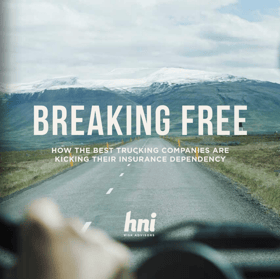2018 will prove to be one of the most challenging years for the trucking industry. Although the challenges faced are not new, the convergence of so many challenges at the same time is unprecedented. Among the top issues facing the trucking industry are:
- Driver Shortage
- Capacity
- Insurance
- Cost/Availability of Equipment
- Regulatory issues

DRIVER SHORTAGE:
The trucking industry is facing a growing shortage of drivers that is pushing retailers to delay non-essential shipments or pay high prices to get their goods delivered on time.
A report from the American Trucking Association says the industry needs to hire almost 900,000 more drivers to meet the demand.
Industry leaders have been complaining about a truck driver shortage for a while, but unlike other industries that have been complaining about worker shortages, there is real evidence both in employment numbers and in business activity that the shortage is starting to have an impact on the economy.
With unemployment low in other industries the deferred/transitional worker due to layoffs is no longer a viable option for motor carriers. Many Truck Driving Schools are reporting lower attendance and are attributing this to lack of interest/knowledge of opportunities in trucking by newer generations and the deferred/transitional worker no longer available.
As the average age of a driver increases proportionately each year due to lack of new entrants into the industry, trucking companies are finding themselves competing for the same “bucket of drivers.” Companies are finding that they must put as much if not more focus on finding and servicing drivers (their internal customer) as they have for years for their external customers:
- Multiple pay increases are becoming the norm. First year entrants are making over $50,000 a year which is more than a 22% increase since 2016.
- Sign On bonuses are skyrocketing
- With the average age of the driver increasing, carriers are discovering a bigger interest in benefits. As a result we are seeing carriers not only offering many more types and diversified benefits for the drivers but are also picking up more of the cost as an incentive to attract new and retain their current drivers.
- Guaranteed pay has become more prevalent and increases in the amount of this guarantee along with less restricted terms for applicability.
- Addressing or eliminating shippers/ receivers that cause delays, freight is too difficult for the driver, driver treatment is poor, or poor conditions.
- More attractive and guaranteed home time policies. Many carriers are changing their operations to more regional or relay to meet these goals.
- New equipment with “all the bells and whistles.” Not just personal comforts but many drivers are learning that they want the safety technology too.
CAPACITY:
“A nationwide truck shortage is forcing thousands of shippers into a tough choice: postpone all but the most important deliveries, or pay dearly to jump to the front of the line.” Wall Street Journal Jan 25, 2018.
“Just one truck was available for every 12 loads needing to be shipped at the start of 2018, the lowest ratio since 2005 and is expected to continue spiraling” NPR
The driver shortage along with the capacity issues are causing trucking companies to change their business plans. At a recent meeting with several trucking executives it was obvious that the traditional “we will just grow as much as freight dictates” plans are being replaced with focus on improving profitability within the company and growing on a limited controlled basis. Many trucking executives are focusing on retaining existing drivers and being much more selective on shippers.
Many trucking executives are implementing scoring systems on their shippers. Using thing such as:
- How well they pay
- How well they fit my future plans
- How soon do they pay
- Is their freight driver friendly
- % of my overall business (enough but not too much)
- Do they cause delays for my drivers
- How do they treat my drivers
Once they score these shippers they are taking from the lowest scoring shippers and giving to the highest. Thus making their company more efficient and profitable.
The economy is playing a major factor in the capacity issues, however the driver shortage is probably just as big of a contributor.
“Freight could go back to where it was a few years ago and I still wouldn’t have enough drivers”
INSURANCE COSTS:
Trucks are getting into more accidents:
- 14% increase in fatalities with trucks over the past 5 years and only .3% increase in miles.
- In spite of newest technologies and our best efforts, trucks are getting in 59% more accidents per mile than in 2010. Injuries from truck accidents are up 48% during this time
Accidents are costing more:
- Accidents are 2 times more likely to exceed $100,000. In 2010, 1.5% of accidents incurred more than $100,000. In 2016 that number nearly doubled to 2.9%.
- Despite being just a small fraction of accident frequency, these large accidents account for approximately 75% of all incurred losses.
- Nuclear Verdicts: Plaintiff’s attorneys have mastered going after trucking companies and as a result some insurance companies have decided to abandon insuring the trucking industry all together.
The cost of cargo insurance for hauling food grade products is increasing:
- With the food modernization act the cost of claims involving food grade product has increased (some over 100%) as carriers receive more claims.
- When claims occurs carriers not only have the cost of the goods, but often now have to pay for the disposal of this product.
Aging workforce is resulting in more (both number and cost) of workers compensation claims. The average age of a truck driver is in the mid 50’s. The wear and tear of many years as a driver is taking its toll. Slip and fall injuries, shoulder injuries, sleep apnea, diabetes, high blood pressure are issues that are very common with today’s trucking companies.
As a result of these costs, motor carriers are recognizing that taking on more risk (increasing deductible or self-insuring) is the only ability to control insurance costs. As a result, risk management is becoming a much larger factor in these companies operations. You can’t take on these risks if you don’t have processes in place to control the cost and number of occurrences. “Safety Directors” are now risk managers and are focusing on proactive implementation of processes and procedures. Proactive management of potential accidents, injuries is essential when the company is taking on more risk.
EQUIPMENT COST:
A truck that cost $100,000 in 2010 can now cost over $150,000.
“While there are myriad variable on the costs, the CAB of an eighteen wheeler usually ranges from $130,000 to $180,000 and new trailers range from $30,000 to $80,000” – The truckers report 2017
At the same time the availability of equipment in 2018 is becoming a challenge. Many manufactures are not committing to new orders (dependent on size of order) until next fall or year due to capacity.
“FTR Reports Record Preliminary Trailer Order for Month of February 2018 at 32,000 units… February was the fifth consecutive month that trailer orders exceeded 30,000 units…..Backlogs should rise above 170,000 units for first time since early 2016."
Lease trucks are a hot commodity and prices and availability are issues for motor carriers.
REGULATORY ISSUES:
Many believe that the implementation of ELDs is a change in the Hours of Service Rules. This is not the case. Regulations did not change with the requirements of AOBRD’s/ELD’s. But the industry has changed. There is no more “looking the other way” no fudging of paperwork, no moving the truck to another site and come back later but don’t log it. Drivers, dispatchers, and companies are now all aware and held accountable.
Some companies have mentioned that their drivers will not have a violation no matter how small or why because they are afraid that if stopped by enforcement this will be reviewable for 7 days. As a result, they won’t drive till this drops off 7 days later. Overreaction? Probably but it is happening.
THE FUTURE?
Not a lot of relief in the near future for the driver shortage. Most proposals are long term:
- Truck platooning
- Self-Driving trucks
- High Pay to attract more to the industry
- Maybe some relief on the horizon for age requirement but even that will take time to have effect on driver shortage
The driver shortage and economy will play a major factor for capacity issues.
With continued capacity issues and increased costs for motor carriers, rates will go up as will the cost of goods and may create inflationary trends.
Risk Management will be more essential for motor carriers.
Non Asset 3PL’s will see competition from asset based trucking companies.
Some shippers (if unable to move their product) will be looking at potential of operating trucks again.
Shipper carrier relationships will be more powerful, will work together.
SECRETS FROM THE BEST TRUCKING COMPANIES: Many trucking executives feel like they don’t have control over their insurance costs. Even when they perform well, insurance companies demand a rate increase.
.png?width=69&height=53&name=Acrisure%20Logo%20(White%20Horizontal).png)


